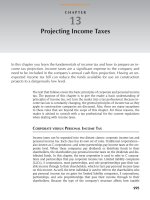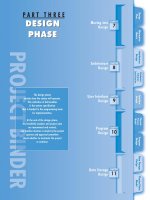Ebook Cardiac pacemakers and resynchronization step-by-step (2e): Part 1
Bạn đang xem bản rút gọn của tài liệu. Xem và tải ngay bản đầy đủ của tài liệu tại đây (24.32 MB, 211 trang )
P1: OTE/PGN
P2: OTE/PGN
BLBK303-FM
BLBK303-Barold
QC: OTE/PGN
June 2, 2010
T1: OTE
17:11
Trim: 276mm×219mm
Printer Name: Yet to Come
i
P1: OTE/PGN
P2: OTE/PGN
BLBK303-FM
BLBK303-Barold
QC: OTE/PGN
June 2, 2010
T1: OTE
17:11
Trim: 276mm×219mm
Printer Name: Yet to Come
Cardiac Pacemakers and
Resynchronization
Step-by-Step
AN ILLUSTRATED GUIDE
Cardiac Pacemakers and Resynchronization Step-by-Step: An Illustrated Guide, Second Edition
S. Serge Barold, Roland X. Stroobandt and Alfons F. Sinnaeve
© 2010 S. Serge Barold, Roland X. Stroobandt, and Alfons F. Sinnaeve. ISBN: 978-1-405-18636-0
i
P1: OTE/PGN
P2: OTE/PGN
BLBK303-FM
BLBK303-Barold
QC: OTE/PGN
June 2, 2010
T1: OTE
17:11
Trim: 276mm×219mm
Printer Name: Yet to Come
Companion Website
With this book you are given free access to a companion resources site:
www.wiley.com/go/barold/cardiac
The website includes more than 300 images taken from this book
You are free to download these images and use them for your own presentations to
students∗
How to access the website:
Look under the label below to see your access code.
Go to www,wiley.com/go/barold/cardiac and enter the code when prompted.
∗
Please note that these images are for your own use for study and instruction. If you are using these
images in a presentation, the reference to the book should always be displayed along with the image.
See website for full copyright information.
ii
P1: OTE/PGN
P2: OTE/PGN
BLBK303-FM
BLBK303-Barold
QC: OTE/PGN
June 2, 2010
T1: OTE
17:11
Trim: 276mm×219mm
Printer Name: Yet to Come
Cardiac Pacemakers
and Resynchronization
Step-by-Step
AN ILLUSTRATED GUIDE
Second Edition
S. Serge Barold
MD, FRACP, FACP, FACC, FESC, FHRS
University of South Florida and Florida Heart Rhythm Institute
Tampa, Florida, USA
Roland X. Stroobandt
MD, PhD
Professor of Medicine
Heart Center, Department of Electrophysiology
University Hospital, Ghent
Ghent, Belgium
Alfons F. Sinnaeve
ing., MSc
Professor Emeritus of Electronic Engineering
Technical University KHBO, Department of Electronics
Oostende, Belgium
A John Wiley & Sons, Ltd., Publication
iii
P1: OTE/PGN
P2: OTE/PGN
BLBK303-FM
BLBK303-Barold
QC: OTE/PGN
June 2, 2010
T1: OTE
17:11
Trim: 276mm×219mm
This edition first published 2010,
F. Sinnaeve
C
Printer Name: Yet to Come
2010 by S. Serge Barold, Roland X. Stroobandt, and Alfons
Blackwell Publishing was acquired by John Wiley & Sons in February 2007. Blackwell’s
publishing program has been merged with Wiley’s global Scientific, Technical and Medical
business to form Wiley-Blackwell.
Registered office:
John Wiley & Sons Ltd, The Atrium, Southern Gate, Chichester, West Sussex, PO19 8SQ, UK
Editorial offices:
9600 Garsington Road, Oxford, OX4 2DQ, UK
The Atrium, Southern Gate, Chichester, West Sussex, PO19 8SQ, UK
111 River Street, Hoboken, NJ 07030-5774, USA
For details of our global editorial offices, for customer services and for information about how
to apply for permission to reuse the copyright material in this book please see our website at
www.wiley.com/wiley-blackwell.
The right of the author to be identified as the author of this work has been asserted in
accordance with the UK Copyright, Designs and Patents Act 1988.
All rights reserved. No part of this publication may be reproduced, stored in a retrieval
system, or transmitted, in any form or by any means, electronic, mechanical, photocopying,
recording or otherwise, except as permitted by the UK Copyright, Designs and Patents Act
1988, without the prior permission of the publisher.
Wiley also publishes its books in a variety of electronic formats. Some content that appears in
print may not be available in electronic books.
Designations used by companies to distinguish their products are often claimed as
trademarks. All brand names and product names used in this book are trade names, service
marks, trademarks or registered trademarks of their respective owners. The publisher is not
associated with any product or vendor mentioned in this book. This publication is designed to
provide accurate and authoritative information in regard to the subject matter covered. It is
sold on the understanding that the publisher is not engaged in rendering professional services.
If professional advice or other expert assistance is required, the services of a competent
professional should be sought.
The contents of this work are intended to further general scientific research, understanding,
and discussion only and are not intended and should not be relied upon as recommending or
promoting a specific method, diagnosis, or treatment by physicians for any particular patient.
The publisher and the author make no representations or warranties with respect to the
accuracy or completeness of the contents of this work and specifically disclaim all warranties,
including without limitation any implied warranties of fitness for a particular purpose. In
view of ongoing research, equipment modifications, changes in governmental regulations, and
the constant flow of information relating to the use of medicines, equipment, and devices, the
reader is urged to review and evaluate the information provided in the package insert or
instructions for each medicine, equipment, or device for, among other things, any changes in
the instructions or indication of usage and for added warnings and precautions. Readers
should consult with a specialist where appropriate. The fact that an organization or Website is
referred to in this work as a citation and/or a potential source of further information does not
mean that the author or the publisher endorses the information the organization or Website
may provide or recommendations it may make. Further, readers should be aware that Internet
Websites listed in this work may have changed or disappeared between when this work was
written and when it is read. No warranty may be created or extended by any promotional
statements for this work. Neither the publisher nor the author shall be liable for any damages
arising herefrom.
Library of Congress Cataloging-in-Publication Data
Barold, S. Serge.
Cardiac pacemakers and resynchronization therapy step-by-step : an illustrated
guide / S. Serge Barold, Roland X. Stroobandt, Alfons F. Sinnaeve. – 2nd ed.
p. ; cm.
Rev. ed. of: Cardiac pacemakers step-by-step. c2004.
Includes bibliographical references and index.
ISBN 978-1-4051-8636-0
1. Cardiac pacemakers–Pictorial works. I. Stroobandt, R. (Roland) II. Sinnaeve, Alfons F.
III. Barold, S. Serge. Cardiac pacemakers step-by-step. IV. Title.
[DNLM: 1. Cardiac Pacing, Artificial–methods–Handbooks. 2. Pacemaker,
Artificial–Handbooks. 3. Electrocardiography–methods–Handbooks. WG 39 B264c 2010]
RC684.P3B365 2010
617.4’120645–dc22
2010010756
ISBN: 9781405186360
A catalogue record for this book is available from the British Library.
Set in 9.5/12 pt Palatino by Aptara R Inc., New Delhi, India
Printed and bound in Singapore
1 2010
iv
P1: OTE/PGN
P2: OTE/PGN
BLBK303-FM
BLBK303-Barold
QC: OTE/PGN
June 2, 2010
T1: OTE
17:11
Trim: 276mm×219mm
Printer Name: Yet to Come
Contents
Preface to the first edition, vii
Preface to the second edition, viii
Abbreviations, ix
Color Plate Section
What is a pacemaker?, 1
Recording pacemaker activity, 2
Fundamentals of electricity, 10
Ventricular stimulation, 19
Pacing leads, 33
Sensing – basic concepts, 40
Sensing – advanced concepts, 58
Basic pacemaker electrocardiography, 71
Other single chamber pacemakers, 83
DDD pacemakers – basic functions, 86
DDD pacemakers – upper rate response, 107
Atrioventricular interval, 123
Retrograde ventriculoatrial synchrony in dual
chamber pacemakers, 128
All dual chamber pacemakers function in the
DDD mode, 141
Types of lower rate timing, 159
Atrial capture, 166
Automatic mode switching, 176
Pacemaker radiography, 191
Oversensing, 196
Troubleshooting, 201
Pacemaker hemodynamics and rate-adaptive
pacing, 214
Pacemaker tachycardias – Part 1, 242
Pacemaker tachycardias – Part 2, 248
Treatment of tachycardia, 252
Pacemaker interference, 256
Pacemaker follow-up, 263
Remote pacemaker monitoring, 308
Special functions, 315
Biventricular pacing and cardiac
resynchronization, 320
Conclusion, 354
Text: Overview of cardiac pacing and cardiac
resynchronization
Cardiac pacing, 357
Implantation, 357
Basic function, 357
v
Power source, 357
Rate or interval?, 358
Single chamber pacemakers, 358
Basic electricity, 360
Chronic pacing threshold and safety margin, 360
Sensing, 362
Polarity: unipolar versus bipolar pacing and
sensing, 363
Ventricular fusion and pseudofusion beats, 363
Operational characteristics of a simple DDD
pacemaker, 363
Crosstalk and crosstalk intervals, 367
Increasing complexity: our simple DDD
pacemaker grows to nine intervals, 367
Upper rate response of DDD pacemakers, 368
Lower rate timing of dual chamber
pacemakers, 369
Phantom programming, 369
Programmability of lower rate, 369
Endless loop tachycardia, 371
Repetitive non-reentrant VA synchrony: the
cousin of endless loop tachycardia, 372
Types of dual chamber pacemakers, 373
Overdrive suppression and the underlying
rhythm, 374
Pacemaker hemodynamics, 374
Rate-adaptive pacemakers, 375
The pacemaker stimulus, 376
Magnet mode, 376
Normal QRS patterns during right ventricular
pacing, 377
Left ventricular endocardial pacing, 378
Manifestations of myocardial infarction in the
paced rhythm, 378
Cardiac memory, 379
Pacemaker alternans, 380
Complications of pacemakers, 380
Non-electrical complications, 380
Electrical complications, 383
Automatic mode switching, 390
Minimizing right ventricular pacing, 392
Effect of drugs and electrolyte imbalance, 394
Magnet application, 395
Capture verification algorithms, 395
Keeping good records, 397
Factors influencing pacemaker longevity, 397
P1: OTE/PGN
P2: OTE/PGN
BLBK303-FM
BLBK303-Barold
vi
QC: OTE/PGN
June 2, 2010
T1: OTE
17:11
Trim: 276mm×219mm
Printer Name: Yet to Come
Pacemaker follow-up, 398
The pacemaker as an implantable Holter
system, 400
Special functions of pacemakers, 404
Cardiac resynchronization (CRT), 405
CRT hemodynamics, 405
CRT with only left ventricular pacing, 405
New York Heart Association class I and II
patients with left bundle branch block and
depressed left ventricular function, 406
Right bundle branch block, 406
CRT in patients with a narrow QRS
complex, 406
Impact of CRT, 407
Alternative routes to left ventricular
pacing, 408
What is a CRT responder?, 408
Complications of CRT implantation, 408
Impact of comorbidities, 409
Programming of CRT devices, 409
Atrial fibrillation and atrial tachyarrhythmia, 420
Congestive heart failure after CRT, 420
Arrhythmias after CRT, 422
Appendix: guidelines, 423
American guidelines for pacemaker
implantation, 423
European guidelines for pacemaker
implantation, 429
Commentary, 433
Further reading, 441
Index, 451
P1: OTE/PGN
P2: OTE/PGN
BLBK303-FM
BLBK303-Barold
QC: OTE/PGN
June 2, 2010
T1: OTE
17:11
Trim: 276mm×219mm
Printer Name: Yet to Come
Preface to the first edition
The impetus for writing this book came from our observations that many healthcare professionals and
young physicians working in emergency rooms, intensive and coronary care units were unable to interpret simple pacemaker electrocardiograms correctly.
Over the years we also heard many complaints from
beginners in the field of cardiac pacing that virtually all, if not all, the available books are too complicated and almost impossible to understand. Indeed,
the ever-changing progress in electrical stimulation
makes cardiac pacing a moving target. Therefore we
decided to take up the challenge and write a book
for beginners equipped with only a rudimentary
knowledge of electrocardiography and no knowledge of cardiac pacing whatsoever. Because many
individuals first see the pacemaker patient after implantation, the book contains little about indications
for pacing and implantation techniques. The book
starts with basic concepts and progressively covers
more advanced aspects of cardiac pacing including
troubleshooting and follow-up.
vii
As one picture is worth a thousand words, this
book tries to avoid unnecessary text and focuses on
visual learning. We undertook this project with the
premise that learning cardiac pacing should be enjoyable. Cardiac pacing is a logical discipline and
should be fun and easy to learn with the carefully
crafted illustrations in this book. The artwork is simple for easy comprehension. Many of the plates are
self-explanatory and the text in the appendix only
intends to provide further details and a comprehensive overview.
Many of the images used to create the illustrations
in this book are taken from CorelDraw and Corel
Mega Gallery clipart collections.
We are grateful to Charlie Hamlyn of Blackwell
Publishing and Tom Fryer of Sparks for their superb
work in the production of this book.
S. Serge Barold
Roland X. Stroobandt
Alfons F. Sinnaeve
P1: OTE/PGN
P2: OTE/PGN
BLBK303-FM
BLBK303-Barold
viii
QC: OTE/PGN
June 2, 2010
T1: OTE
17:11
Trim: 276mm×219mm
Printer Name: Yet to Come
Preface to the second edition
The first edition of the book has been well received
all over the world and translated into Japanese, Chinese and Polish. The same format has been retained
in the second edition because of its wide popularity and the frequent positive feedback that it facilitates learning and understanding. Many new plates
were added. A few plates were upgraded and a few
were deleted when the message was no longer relevant. We have reviewed the advances in cardiac
pacing over the last seven years and introduced an
important new presentation on cardiac resynchronization, which is a rapidly growing field. The incorporation of many suggestions from readers has
also contributed to the increased size of the second
edition. For example, the latter now includes an expanded text (including a large section on cardiac
resynchronization), a discussion of indications, and
a list of pertinent references. As before, we omitted
the technical details of pacemaker implantation and
lead extraction. We are grateful to Thomas V. Hartman, Kate Newell, and Cathryn Gates from WileyBlackwell Publishing for their outstanding work in
the production of this book.
S. Serge Barold
Roland X. Stroobandt
Alfons F. Sinnaeve
P1: OTE/PGN
P2: OTE/PGN
BLBK303-FM
BLBK303-Barold
QC: OTE/PGN
June 2, 2010
T1: OTE
17:11
Trim: 276mm×219mm
Printer Name: Yet to Come
Abbreviations
A
ACC
AEGM
AEI
AF
AFR
Ah
AH
AHA
AHR
AMS
AP
APC
AR
As
AS
AT
ATP
ATR
AV
AVE
AVI
AVI-U
BiV
BLR
BOL
BP
BP
bpm
BV
C
CAD
CHF
CO
CRT
CRT-D
CS
CSNRT
CT
ECG
EGM
ELT
EMI
EOL
ampere
American College of Cardiology
atrial electrogram
atrial escape interval
atrial fibrillation
atrial flutter response
amperehour
atrial–His
American Heart Association
atrial high rate
automatic mode switching
atrial paced event
atrial premature complex
atrial event sensed in the refractory
period
amperesecond
atrial sensed event
atrial tachycardia
antitachycardia pacing
atrial tachycardia response
atrioventricular
atrioventricular extension
atrioventricular interval (also called
AV delay)
atrioventricular interval, unblanked
biventricular
basic lower rate
beginning-of-life
biventricular paced event
blood pressure
beats per minute
biventricular
coulomb
coronary artery disease
congestive heart failure
cardiac ouput
cardiac resynchronization therapy
cardiac resynchronization therapy
device and defibrillator
coronary sinus
corrected sinus node recovery time
computed tomography
electrocardiogram
electrogram
endless loop tachycardia
electromagnetic interference
end-of-life
ix
EOS
ER
ERI
ERT
ESCI
ESCR
FARI
FCC
HCM
HF
HR
HRS
HRV
HV
Hz
I
IACD
ICD
IV
LA
LBBB
LBT
LRI
LRL
LV
LVEF
LVESV
LVOT
A
mA
mEq
MI
MICS
MRI
ms
MSDR
MTR
mV
MV
MVP
NYHA
OVI
PAVB
pAVI
PM
PMT
end-of-service
evoked response
elective replacement indicator
elective replacement time
escape interval
escape rate
filtered atrial rate interval
Federal Communications Commission
hypertrophic cardiomyopathy
heart failure
heart rate
Heart Rhythm Society
heart-rate variability
His–ventricular
hertz
current (in amps, A)
intraatrial conduction delay
implantable cardioverter-defibrillator
interventricular
left atrium
left bundle branch block
listen before talk
lower rate interval
lower rate limit
left ventricle
left ventricular ejection fraction
left ventricular end-systolic volume
left ventricular outflow tract
microampere
milliampere
milliequivalent
myocardial infarction
Medical Implant Communications
System
magnetic resonance imaging
millisecond
maximum sensor-driven rate
maximum tracking rate
millivolt
minute volume
managed ventricular pacing
New York Heart Association
open ventricular interval
postatrial ventricular blanking period
AV interval after a paced event
pacemaker
pacemaker-mediated tachycardia
P1: OTE/PGN
P2: OTE/PGN
BLBK303-FM
BLBK303-Barold
x
QC: OTE/PGN
June 2, 2010
ppm
PR
PVAB
PVARP
PVARP-U
PVC
PVE
pVRP
R
RA
RAM
RBBB
RF
RNRVAS
ROM
RR
RRT
RV
RVA
RVOT
SAI
SAR
SAS
sAVI
SDI
SDR
SND
T1: OTE
17:11
Trim: 276mm×219mm
Printer Name: Yet to Come
pacing per minute
peripheral resistance
postventricular atrial blanking period
postventricular atrial refractory period
postventricular atrial refractory period,
unblanked
premature ventricular complex
(= VPC)
premature ventricular event
ventricular refractory period after
pacing
resistance (in ohms, )
right atrium
random-access memory
right bundle branch block
radiofrequency
repetitive non-reentrant VA
synchrony
read-only memory
respiratory rate
recommended replacement time
right ventricle
right ventricular apex
right ventricular outflow tract
spontaneous atrial interval
spontaneous atrial rate
synchronous atrial stimulation
AV interval after a sensed event
sensor-driven interval
sensor-driven rate
sinus node dysfunction
SV
sVRP
SVT
TARP
TCL
TDI
TEE
TV
U
URI
URL
V
VA
VB
VEGM
VF
VHR
VP
VPC
VPI
VPR
VR
VRP
VRP-U
VS
VSP
VT
WI
stroke volume
ventricular refractory period after
sensing
supraventricular tachycardia
total atrial refractory period
tachycardia cycle length
tissue Doppler imaging
transesophageal echocardiography
tidal volume
voltage (in volts, V)
upper rate interval
upper rate limit
volt
ventriculoatrial
ventricular blanking period
ventricular electrogram
ventricular fibrillation
ventricular high rate
ventricular paced event
ventricular premature complex
ventricular paced interval
ventricular paced rate
ventricular event sensed in the
refractory period
ventricular refractory period
ventricular refractory period,
unblanked
ventricular sensed event
ventricular safety pacing
ventricular tachycardia
Wenckebach interval
P1: OTE/PGN
part-Ia
P2: OTE/PGN
BLBK303-Barold-fig
QC: OTE/PGN
March 9, 2010
T1: OTE
9:42
Trim: 276mm×219mm
Printer Name: Yet to Come
1
Cardiac Pacemakers and Resynchronization Step-by-Step: An Illustrated Guide, Second Edition
S. Serge Barold, Roland X. Stroobandt and Alfons F. Sinnaeve
© 2010 S. Serge Barold, Roland X. Stroobandt, and Alfons F. Sinnaeve. ISBN: 978-1-405-18636-0
P1: OTE/PGN
part-Ia
P2: OTE/PGN
BLBK303-Barold-fig
QC: OTE/PGN
March 9, 2010
T1: OTE
9:42
Trim: 276mm×219mm
Printer Name: Yet to Come
2
Cardiac Pacemakers and Resynchronization Step-by-Step: An Illustrated Guide, Second Edition
S. Serge Barold, Roland X. Stroobandt and Alfons F. Sinnaeve
© 2010 S. Serge Barold, Roland X. Stroobandt, and Alfons F. Sinnaeve. ISBN: 978-1-405-18636-0
P1: OTE/PGN
part-Ia
P2: OTE/PGN
BLBK303-Barold-fig
QC: OTE/PGN
March 9, 2010
T1: OTE
9:42
Trim: 276mm×219mm
Printer Name: Yet to Come
3
P1: OTE/PGN
part-Ia
P2: OTE/PGN
BLBK303-Barold-fig
4
QC: OTE/PGN
March 9, 2010
T1: OTE
9:42
Trim: 276mm×219mm
Printer Name: Yet to Come
P1: OTE/PGN
part-Ia
P2: OTE/PGN
BLBK303-Barold-fig
QC: OTE/PGN
March 9, 2010
T1: OTE
9:42
Trim: 276mm×219mm
Printer Name: Yet to Come
5
P1: OTE/PGN
part-Ia
P2: OTE/PGN
BLBK303-Barold-fig
6
QC: OTE/PGN
March 9, 2010
T1: OTE
9:42
Trim: 276mm×219mm
Printer Name: Yet to Come
P1: OTE/PGN
part-Ia
P2: OTE/PGN
BLBK303-Barold-fig
QC: OTE/PGN
March 9, 2010
T1: OTE
9:42
Trim: 276mm×219mm
Printer Name: Yet to Come
7
P1: OTE/PGN
part-Ia
P2: OTE/PGN
BLBK303-Barold-fig
8
QC: OTE/PGN
March 9, 2010
T1: OTE
9:42
Trim: 276mm×219mm
Printer Name: Yet to Come
P1: OTE/PGN
part-Ia
P2: OTE/PGN
BLBK303-Barold-fig
QC: OTE/PGN
March 9, 2010
T1: OTE
9:42
Trim: 276mm×219mm
Printer Name: Yet to Come
9
P1: OTE/PGN
part-Ia
P2: OTE/PGN
BLBK303-Barold-fig
QC: OTE/PGN
March 9, 2010
T1: OTE
9:42
Trim: 276mm×219mm
Printer Name: Yet to Come
10
Cardiac Pacemakers and Resynchronization Step-by-Step: An Illustrated Guide, Second Edition
S. Serge Barold, Roland X. Stroobandt and Alfons F. Sinnaeve
© 2010 S. Serge Barold, Roland X. Stroobandt, and Alfons F. Sinnaeve. ISBN: 978-1-405-18636-0
P1: OTE/PGN
part-Ia
P2: OTE/PGN
BLBK303-Barold-fig
QC: OTE/PGN
March 9, 2010
T1: OTE
9:42
Trim: 276mm×219mm
Printer Name: Yet to Come
11
P1: OTE/PGN
part-Ia
P2: OTE/PGN
BLBK303-Barold-fig
12
QC: OTE/PGN
March 9, 2010
T1: OTE
9:42
Trim: 276mm×219mm
Printer Name: Yet to Come
P1: OTE/PGN
part-Ia
P2: OTE/PGN
BLBK303-Barold-fig
QC: OTE/PGN
March 9, 2010
T1: OTE
9:42
Trim: 276mm×219mm
Printer Name: Yet to Come
13
P1: OTE/PGN
part-Ia
P2: OTE/PGN
BLBK303-Barold-fig
14
QC: OTE/PGN
March 9, 2010
T1: OTE
9:42
Trim: 276mm×219mm
Printer Name: Yet to Come









